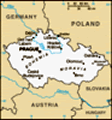Advertisement
Published: October 13th 2017
This morning we walked ten minutes to Wenceslas Square, and continued on to the Powder Tower, where we were to meet our guide for the World War II in Prague Tour. I was particularly interested to hear the story of the assassination of Reinhard Heydrich, the only successful killing of a senior Nazi leader during WWII.
Our guide for the tour was Marketa, and she led us around the inner city of Prague, providing interesting information, showing us historical photos of key events, and taking us to the location of where those key events took place. Marketa also provided a brief history of how Czechoslovakia was formed in 1918, following the collapse of the Austro-Hungarian Empire after World War I, and how the country became a Nazi German Protectorate in 1938, thanks to the appeasement policies of the Allies.
Marketa led us through the Jewish Quarter, informing us that Prague’s Jewish Synagogues were spared destruction, so that they could serve Hitler’s perverse plan to establish “Museums of the Extinct Race of Jews” after the war. We were shown brass plates on the pavements with the names of the former jewish residents who were killed in
the Holocaust. Around Prague are plaques with the names of Czech Partisans who fought the Nazis at the locations where they were killed.
Marketa provided us with access to enter the cellars beneath the Town Hall Astronomical Clock to see where the Czech Partisan fighters launched their attacks in 1945 to rid the city of their Nazi oppressors, and where a hospital was located to treat injured partisans. We were provided with brief details of Operation Anthropoid, the secret operation to kill Reinhard Heydrich, the Governor of the Protectorate of Bohemia and Moravia, who was appointed to the role in 1941. Heydrich came to Prague to "strengthen policy, carry out countermeasures against resistance, and keep up production quotas of Czech motors and arms that were extremely important to the German war effort". He was the author of the Final Solution, and became known as the Butcher of Prague, The Blonde Beast and The Hangman.
We found the two and a half hour fixed price, pay at the end tour, very interesting, and were appreciative of Marketa’s skills as a guide, and for her humour. I had to laugh when one of the tour participant’s
said to Marketa, “what if I decide to leave the tour half way through?” Marketa replied “Are you a fast runner?” to which she then added “Because I am”.
After finishing the guided tour, we wandered along the river, through a Church on the Old Town Square, then continued on to walk across the Charles Bridge in the daylight. After retracing our steps across the bridge, we walked along the river to the “melting building, the Dance House, then turned left to find the Karel Boromejsky Church, an Eastern Orthodox church dedicated to Saints Cyril and Methodius, who first brought the gospel to the Slavic Peoples. This was the church where the Czech Partisans who had assassinated Reinhard Heydrich had sought and were provided with refuge.
On 27 May 1942 at 10:30am, Heydrich proceeded on his daily commute from his home to Prague Castle. Gabčík and Kubiš waited at the tram stop at a tight curve near Bulovka Hospital. Heydrich's green, open-topped Mercedes 320 Convertible reached the curve two minutes later. Gabčík stepped in front of the vehicle and tried to open fire with his Sten submachine gun, but it jammed. Heydrich ordered his
SS driver, Klein, to stop the car, then stood up to shoot Gabčík with his Luger Pistol. Kubiš threw a modified anti-tank grenade (concealed in a briefcase) at the vehicle. Its fragments ripped through the car's right rear bumper, embedding shrapnel and fibres from the upholstery in Heydrich's body upon detonation, even though the grenade failed to enter the car. Heydrich was badly injured, however, after a week of treatment by the best German doctors, he appeared to be recovering when he suddenly fell ill, collapsed and died. It is believed he died of sepsis.
The Nazi retaliation ordered by Hitler via Himmler was brutal, nonetheless. More than 13,000 were arrested, including Jan Kubiš' girlfriend, Anna Malinová, who subsequently died in Mauthausen Concentration Camp. The villages of Lidice and Lezaky, which were believed to have links to the assassins, were burned and the ruins of Lidice levelled. According to one estimate, 5,000 people were murdered in the reprisals.
The partisans were betrayed by a fellow partisan for a large reward, and the church was laid seige to on 8
th June. Kubiš, Adolf Opalka, and Jaroslav Svarc were killed in the prayer loft after a
two-hour gun battle. Gabčík, Josef Valcik, Josef Bublik and Jan Hruby committed suicide in the crypt beneath the church after repeated SS attacks, attempts to smoke them out with tear gas, and Prague fire brigade trucks brought in to try to flood the crypt.The German SS and police suffered casualties, as well, with fourteen SS allegedly killed and 21 wounded, according to one report.
The National Memorial to the Heroes of the Heydrich Terror is located in the underground crypt of the church, which was a sombre and moving place to visit. The crypt serves as a memorial to the brave Czech Partisans who took out one of the worst mass murderers of the 20
th century, including several items belonging to these brave men.
My last question to Marketa on the tour was, “was it worth it to assassinate Reinhard Heydrich?”. Her answer was “that is a very good question. After the war, even one of the few residents of Lidice who survived the massacre, stated that it was worth it to assassinate Heydrich”.
Tomorrow we leave Prague and head for the hills, to Bohemian Paradise National Park in North West
Czech Republic.
Advertisement
Tot: 0.345s; Tpl: 0.012s; cc: 10; qc: 54; dbt: 0.0844s; 1; m:domysql w:travelblog (10.17.0.13); sld: 1;
; mem: 1.2mb















